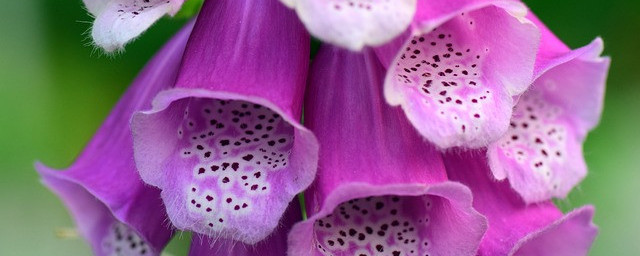
Foxglove, also known by its scientific name Digitalis purpurea, is a stunning flowering plant that is highly sought after for its beauty and elegance. While commonly known for its medicinal properties, which include the production of the heart medication digoxin, foxglove also serves as an excellent cut flower. Its tall, spiky blooms and vibrant colours make it a popular choice for floral arrangements and bouquets. It’s foxglove flowering time and we love foxglove as cut flowers.
Striking Foxglove
One of the most striking features of foxglove as a cut flower is its distinctive shape and structure. The flower spikes of foxglove can reach impressive heights, often reaching up to four feet tall. These tall stems, adorned with clusters of bell-shaped flowers, create a dramatic and eye-catching display. The flowers themselves come in a variety of colours, including shades of pink, purple, white, and even yellow, allowing for versatility in floral designs.
Another reason why foxglove is a favoured choice for arrangements is its long-lasting nature. When properly cared for, foxglove can remain fresh and vibrant for up to two weeks. This longevity makes it an ideal choice for special occasions or events that require flowers to maintain their beauty for an extended period. Foxglove’s ability to withstand the test of time ensures that it will continue to captivate and delight viewers long after it has been cut.

Elegant and sophisticated
Furthermore, foxglove’s unique appearance adds a touch of whimsy and charm to any floral arrangement. The bell-shaped flowers, with their spotted throats and delicate petals, create a sense of enchantment and allure. Whether used as a focal point or as an accent flower, foxglove adds a touch of elegance and sophistication to any bouquet. When combined with other complementary blooms, such as roses, lilies, or delphiniums, foxglove can create a visually stunning and harmonious arrangement.
In addition to its aesthetic appeal, foxglove is also relatively easy to care for as a cut flower. To ensure the longevity of foxglove blooms, it is essential to start with freshly cut stems. When selecting foxglove, look for stems with flowers that have just begun to open. This will allow the flowers to fully develop and remain vibrant for a more extended period. It is also crucial to remove any foliage that will be submerged in water, as this can lead to bacterial growth and reduce the lifespan of the flowers.
Long vase life
To provide optimal care for foxglove, place the stems in a clean vase filled with fresh water. Adding flower preservatives or a few drops of bleach to the water can help prevent bacterial growth and extend the life of the blooms. It is recommended to change the water every two to three days and trim the stems at an angle to ensure proper water uptake. Additionally, placing the arrangement in a cool location away from direct sunlight or drafts can help prolong the lifespan of the flowers.

As with any cut flower, it is essential to handle foxglove with care. The stems of foxglove contain toxins that can be harmful if ingested or come into contact with the skin. It is advisable to wear gloves when handling foxglove and to keep it out of reach of children or pets. By taking these precautions, you can enjoy the beauty of foxglove in your home or event space without compromising safety.
Therapeutic use
Herbalists have long recognized the therapeutic potential of foxglove (Digitalis purpurea) and utilize it for various purposes. Foxglove contains powerful glycosides, particularly digoxin, which have been traditionally used in herbal medicine. Herbalists primarily use foxglove for its cardiac properties, as it can help regulate heart rhythm, strengthen heart contractions, and improve overall cardiovascular health. Foxglove is commonly prescribed for conditions such as congestive heart failure, arrhythmias, and hypertension.

However, it is crucial to note that foxglove should only be used under the guidance of a qualified herbalist or healthcare professional. The dosage and administration of foxglove must be carefully monitored, as the glycosides can be toxic in high amounts. Overdosing on foxglove can lead to severe symptoms, including nausea, vomiting, blurred vision, and even cardiac arrest. Therefore, it is essential to consult an expert who can ensure the safe and effective use of foxglove as a medicinal herb.
Handle Foxglove with care
For flower farmers growing foxglove for cut flowers, there are several precautions to consider. Firstly, it is important to handle the plant with care, as all parts of the foxglove plant, including the leaves, stems, and flowers, contain toxic compounds. Wearing gloves while harvesting and handling the plant can help minimize the risk of accidental ingestion or contact with the skin.

Secondly, it is crucial to properly label and store the harvested foxglove alongside other flowers. This will help prevent accidental ingestion or exposure by anyone who may come into contact with the flowers. Additionally, keeping foxglove separate from other edible or medicinal plants is essential to avoid confusion or cross-contamination.
Lastly, farmers should be aware of the potential risks associated with foxglove and take appropriate measures to protect themselves and their customers. This includes providing clear warnings about the toxicity of the plant, educating customers about proper handling and disposal, and ensuring that the cut flowers are not accessible to children or pets.
By following these precautions, flower farmers can safely grow foxglove for cut flowers while minimizing the risk of accidental exposure or ingestion.
Conclusion
Foxglove is a remarkable choice for those seeking a unique and captivating cut flower. Its tall, spiky blooms and vibrant colours make it a visually stunning addition to any floral arrangement or bouquet. With proper care, foxglove can remain fresh and vibrant for up to two weeks, making it an ideal choice for special occasions or events. Its distinctive shape and structure, combined with its long-lasting nature, contribute to its popularity as, not only an addition to a home garden, but a crop for a flower farm.




Wow, this piece really opened my eyes to the beauty and versatility of foxglove! I’ve always admired these flowers from afar, but I didn’t realize just how much they have to offer. The fact that they can reach up to four feet tall and come in a variety of colors like pink, purple, white, and yellow is truly impressive. I can see why they’d make a dramatic and eye-catching display in any floral arrangement.
I also found it interesting that foxglove is not just a pretty face, it’s a hardy flower too. The fact that it can stay fresh and vibrant for up to two weeks is a big plus, especially for special occasions where you want the flowers to last. And the care tips are really helpful. I didn’t know that removing submerged foliage and changing the water every two to three days could help extend the life of the blooms.
But what struck me the most is the medicinal properties of foxglove. I had no idea that it’s used in heart medication and can help with conditions like congestive heart failure and hypertension. That’s pretty amazing, although the caution about its toxicity is definitely something to keep in mind.
Overall, I think foxglove is a fantastic flower. It’s beautiful, long-lasting, and even has medicinal properties. But like with anything, it’s important to handle it with care and respect its potential risks. I’m definitely going to look at foxglove in a new light now!